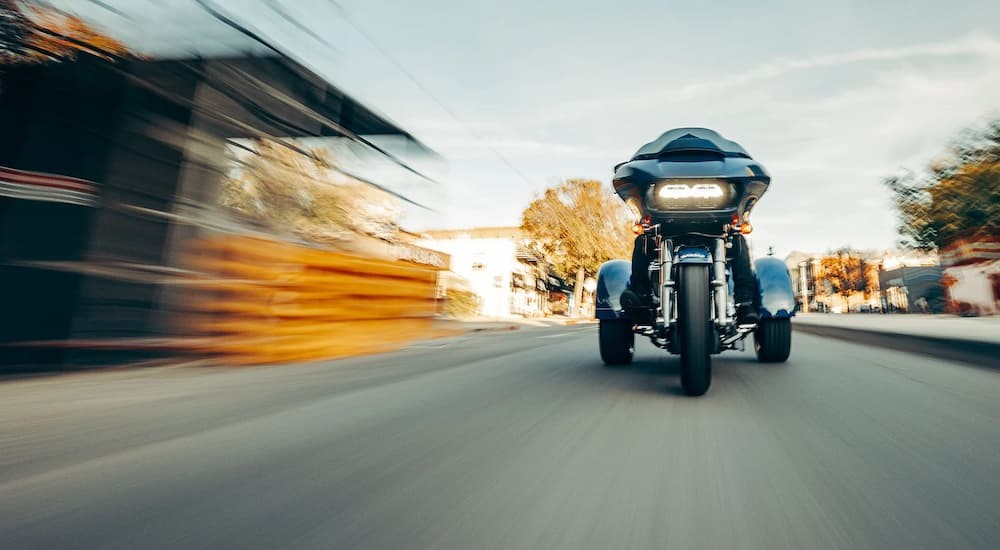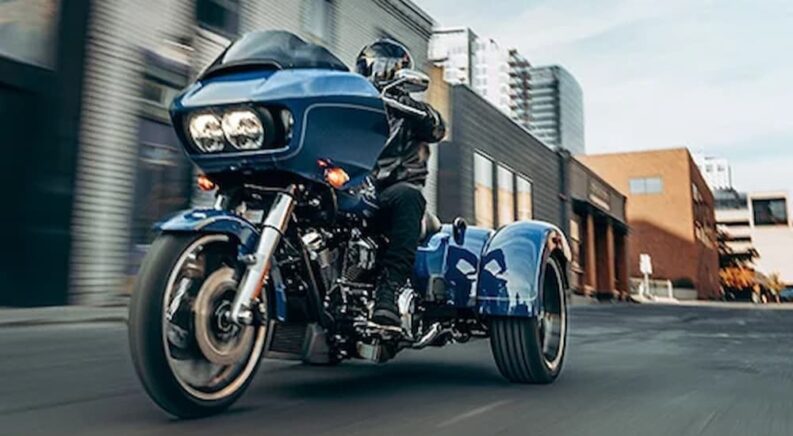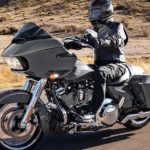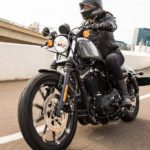One of the most common misconceptions in the motorcycle industry is that three-wheelers or trikes can’t offer the same freedom or riding experience as their two-wheeled counterparts. Trike riders know this isn’t true, of course. Many argue that the trike reflects the rebelliousness and outlaw spirit that’s defined the Harley-Davidson brand since its founding in the 1900s.
The recent debut of the 2023 Harley-Davidson Road Glide 3 has ignited a frenzy among riders because for the first time in history, Harley-Davidson offers the legendary performance of a Grand American Touring bike on a three-wheeled platform. Trike conversion kits have been around for years, but this is the first time Harley-Davidson has offered a three-wheeled version of their popular Road Glide straight from the factory. We’ll look at this revolutionary new trike, but genuinely appreciating everything it offers requires revisiting the evolution of the Harley-Davidson trike, and the manufacturer’s nearly 40-year delay in offering trikes to the public.

A Worthwhile Discovery: The Forecar, Package Truck, and Servi-Car
The first iteration of a Harley-Davidson trike occurred in 1913, a decade after the Harley and Davidson brothers and friends released their first motorcycle. The 1913 Forecar was another product of their ingenuity, instantly turning heads as a “two-one” motorcycle, with two wheels in the front and one in the rear, similar to a modern Can-Am Spyder. Its unique design and expansive cargo space struck a chord with many riders, and Harley-Davidson learned a valuable lesson: riders appreciated bikes that could haul gear and other necessities.
Harley-Davidson applied that lesson in a different way in 1915 when the company released the Package Truck. Essentially a motorcycle with a sidecar, Harley-Davidson transformed the sidecar into a cargo box designed for business and commercial use. The result was phenomenal, streamlining deliveries for businesses and postal carriers. The Package Truck paved the way for the more capable and successful Servi-Car, which debuted in 1931.
The Servi-Car marks the first significant trike success for Harley-Davidson, earning a prominent place in the Harley-Davidson lineup for over four decades to become one of the longest-produced motorcycles in the company’s history. But what made the Servi-Car so successful? The trike was initially designed for car dealerships because, at the time, dealerships made home deliveries when customers brought their vehicles in for repairs. The Servi-Car streamlined these deliveries because it featured a tow bar that meant the dealership’s driver could tow the bike behind the customer’s vehicle, make the delivery, and then ride the Servi-Car back to the dealership.
With the trike’s cargo box doubling as a moving billboard and its flathead engine churning out ample power, demand for the Servi-Car skyrocketed. Suddenly, dealerships weren’t the only ones benefiting from the trike. Everyone from police officers to ice cream vendors and other professionals relied on them daily. The trike’s popularity made it a staple in the lineup, with Harley-Davidson making few modifications over the years. In 1964, it made history when it introduced the first electric starter to the Harley-Davidson fleet, but its popularity slowly dwindled and led to its end in 1973.
Rebellious Ingenuity: Decades of Custom Trikes
By the 1970s, the motorcycle industry saw another shift when manufacturers started developing trike prototypes. While models like the Servi-Car were popular in previous years, there was a stereotype among riders that three-wheeled motorcycles were less than or subpar to a traditional two-wheeled road hog. Manufacturers tackled that stereotype over the next four decades by building overly modern models like the Campagna T-Rex, which debuted in the late 1980s.
Harley-Davidson joined the craze and developed the Trihawk 304 in the 1980s, but never put the model into production. Instead, riders started converting their Harley-Davidson two-wheelers into custom trikes that suited their needs, further establishing Harley-Davidson riders for their rebellious ingenuity. As we saw with the rise of the chopper, the new mantra was that just because a trike wasn’t available in the Harley-Davidson lineup didn’t mean it was impossible or unattainable.
By the new millennium, Harley-Davidson was well aware of these aftermarket trikes and hired legendary race car builder John Buttera to design new models for the company. He designed and built the Penster, a tilting reverse trike, in 1998. The model was finalized by 2006 but, like the Trihawk, never made it into production. Three years later, Harley-Davidson debuted its first official modern trike: the Tri-Glide Ultra Classic.
Harley-Davidson Joins the Trike Craze: The Tri-Glide Ultra, Freewheeler, and Road Glide 3
The 2009 Tri-Glide Ultra Classic was revolutionary because it proved a trike could offer the same bold design, aggressive stance, and iconic rumble of a two-wheeled Harley-Davidson. Based on the Electra Glide Ultra Classic touring bike, the Tri Glide officially succeeded the Harley-Davidson Servi-Car. It also marked the manufacturer’s partnership with Lehman Trikes until 2012, when Harley-Davidson officially took over production.
Harley-Davidson capitalized on the growing demand for trikes in 2014 by introducing the Freewheeler, a budget-friendly option with fewer amenities and features. Today, Harley-Davidson has expanded its trike lineup yet again, making history with the 2023 Road Glide 3. Sandwiched between the Freewheeler and Tri Glide Ultra, the Road Glide 3 is inspired by one of the best-selling Grand American Touring bikes in the segment.
Turning Heads With the Road Glide 3
Harley-Davidson has spent the last few years consistently trimming its lineup, so the addition of the Road Glide 3 to expand the trike fleet is notable for 2023. Moreover, the company’s investment in designing an all-new trike proves the stereotype surrounding three-wheeled motorcycles isn’t discouraging riders from exploring the greater stability and many other benefits of chasing the horizon on three wheels. If anything, models like the 2023 Road Glide 3 entice more riders to the segment.
The Road Glide 3 accomplishes this feat by taking many cues from the Road Glide, a Grand American Touring bike renowned for its exceptional luxury and performance. The Road Glide 3 adopts the same mentality, but on a larger footprint. As a result, it’s more appealing for long-distance travel because of its aerodynamic design and integrated features, like the 2.0-cu ft trunk that can handle all the necessities and more. Moreover, Harley-Davidson ensures the Road Glide 3 remains true to its roots by equipping it with the proven Milwaukee-Eight 114 V-Twin engine that offers the most displacement in the segment and the necessary power to push the trike to its limits as you travel across state lines looking for adventure.
As a trike destined for long journeys, the Road Glide 3 is a modern marvel on three wheels and a stark contrast to the bare-bones Servi-Car of decades past. Designed for comfort at any speed, the Road Glide 3 makes every ride more enjoyable with its plush seating and integrated technology, like the Boom! Box GTS system that keeps you entertained and connected wherever the road takes you. The system gives you seamless access to your iPhone via Apple CarPlay, allowing you to use the touchscreen display or integrated controls on the handlebars, so your focus always stays on the road ahead.
Breaking the Stereotype One Trike at a Time
The 2023 Road Glide 3 marks another important chapter in the history of Harley-Davidson. It embodies everything riders love about the Road Glide, but puts it on three wheels, and successfully proves that riding a trike isn’t a sacrifice in style, performance, or comfort. Instead, just as the Servi-Car revealed its widespread versatility and capability over its 41-year run, the Road Glide 3 and its three-wheeled siblings defy the stereotypes associated with trikes. Moreover, trikes are perhaps the best representation of the rebellious ingenuity that’s defined the Harley-Davidson lineup for the last century, because for decades, riders had no other option but to convert their two-wheeled road hogs into three-wheelers themselves. If that doesn’t reflect the penchant for customization that characterizes Harley-Davidson, then what does?




